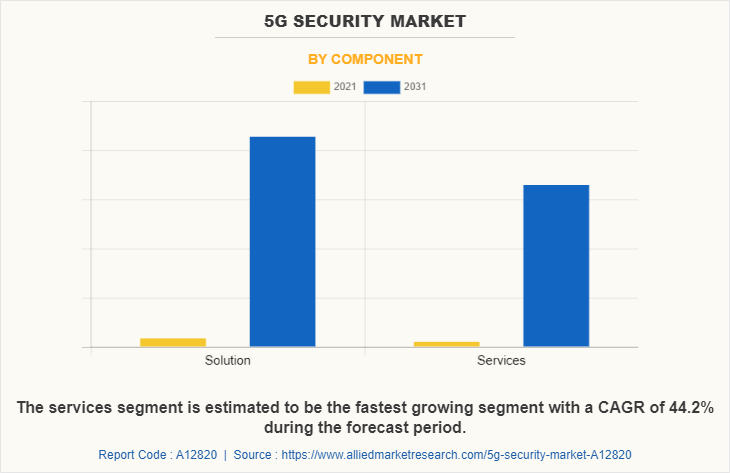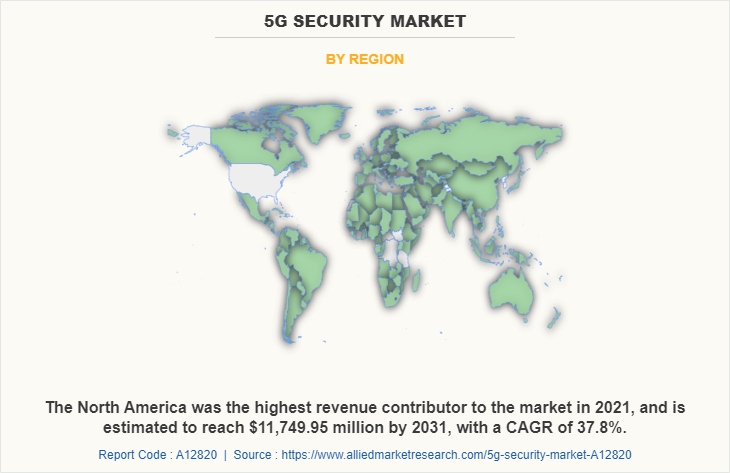5G Security Market Insights, 2031
The global 5G security market was valued at USD 1.3 billion in 2021, and is projected to reach USD 37.8 billion by 2031, growing at a CAGR of 40.5% from 2022 to 2031.
5G has the potential to make the world much more connected. Devices in locations without access to traditional broadband networks can be deployed using 5G network connectivity. Higher speeds, lower latency, and increased capacity make it a potential option for devices where 4G LTE was not a viable option. However, with this growth in systems connected to 5G networks also comes potential security implications. Businesses deploying 5G-connected devices need security solutions capable of monitoring and securing them against cyber threats. Such factor creates numerous opportunities for the 5G security market during the forecast period.

Furthermore, the business world is undergoing an unprecedented period of technological advancement. Resources such as the Internet of Things (IoT), big data and cloud computing have already revolutionized business and promise even more disruption. Further, many businesses are already moving towards a state of 5G security, which is a forward step for modern industry. It could bring both considerable benefits and more opportunities to the business. Moreover, latest 5G trends and emerging technology to meet the evolving challenges in scaling 5G security market. Hence, various industry vertical such as healthcare, IT & telecom, retail, government, and other sectors are adopting 5G security due to such benefits. This factor creates lucrative growth opportunities in the 5G security market.
Factors such as growing digitalization and internet penetration around the world are positively impacting the growth of the 5G security market. In addition, the increase in adoption of 5G technology across enterprises to enhance operation & productivity strengthens the growth of the 5G security market trends for future. Furthermore, rising adoption of IoT, AI, big data and cloud technology are expected to provide lucrative growth opportunities for the market during the forecast period. However, security concerns and initial investment costs, hamper the growth of the market. The 5g security market is segmented into Deployment Mode, Organization Size, Network Component Security, Architecture, Industry Vertical and Component.
Segment Review
The 5G security market is segmented into component, deployment mode, organization size, network component security, architecture, industry vertical, and region. By component, it is bifurcated into solution and services. On the basis of deployment mode, it is categorized into on-premises and cloud. By organizational size, the market is segregated into small & medium-sized enterprises and large enterprises. By network component security, it is divided into radio access network security and core security. By architecture, it is bifurcated into 5G NR standalone and 5G NR Non-standalone. By industry vertical, the 5G security market is classified into manufacturing, IT & telecom, healthcare, retail, energy & utilities, automotive, media & entertainment, and others. Region wise, it is analyzed across North America, Europe, Asia-Pacific, and LAMEA.

On the basis of component, the global 5G security market share was dominated by the solution segment in 2021 and is expected to maintain its dominance in the upcoming years. Owing to advances in technologies enabling 5G security to transform industries globally, such as BFSI, manufacturing, and healthcare. However, the services segment is expected to witness the highest growth, as 5G security services reduce the time and costs associated with optimizing systems in the initial phase of deployment.

By region, North America dominated the market share in 2021 for the 5G security market. The increasing investment in advanced technologies such as artificial intelligence, machine learning, IoT, big data and cloud computing to improve businesses and the customer experience are expected to drive growth in the market in this region. However, Asia-Pacific is expected to exhibit the highest growth during the forecast period. This is attributed to an increase in penetration of digitalization and higher adoption of connected technology, are anticipated to provide lucrative growth for the market in this region.
Key players in the 5g security such as Palo Alto Networks Inc, Trend Micro Inc., IBM Corporation, AT&T Inc., Juniper Networks Inc., Telefonaktiebolaget LM Ericsson, Huawei Technologies Co., Ltd., Qualcomm Incorporated, Intel Corporation, Nokia Corporation
Top Impacting Factors
Increase in Use of Network Slicing to Deliver 5G Services Globally.:
Network slicing is one of the types of virtual networking architecture that is nearly same as software-defined networking (SDN) and network functions virtualization (NFV). These technologies are developed to achieve software-based automation in modern networks. Mobile operators and telecommunication vendors are preparing themselves for the implementation and adoption of 5G technology. 5G networks present a revolution over last generation 4G networks in terms of capacity, performance, and spectrum-access in radio networks, and are designed for extremely flexible and highly programmable environment. Network slicing helps service providers to achieve these goals by allowing single network that can be used to offer various services, which is based on the requirements of users. Furthermore, it helps communication service operators to minimize capital expenditure and operational expense.
For instance, in October 2020, Nokia Corporation launched first ever commercial network slicing for 5G network. It includes new network management, controller, and orchestration capabilities in its solution, by enabling mobile operators for the first time to rapidly deliver and assure network slicing services within minutes instead of hours. Moreover, in January 2021, Ericsson launched 5G network slicing-based radio access network service that will enable communications service providers to deliver customized 5G services with guaranteed high performance. Thus, all these factors collectively contribute toward the growth of the 5G security industry.
Robust Deployment of Next-generation 5G Technology in Smart Cities:
The key attributes of 5G networks that will benefit smart cities include higher speed and more connections, which enable wireless connectivity in unprecedented locations, from street lights to sewer holes. This further facilitates quicker and more adaptive response times that support time-sensitive applications such as vehicle-to-vehicle communications and ultra-low-power connections, such as sensors for leak detection in water mains. In addition to a higher speed to upload and download data, 5G technology ensures short latency times and the ability to connect multiple devices simultaneously.
Furthermore, it paves the way for the development and deployment of new applications in smart cities ranging from monitoring air quality, energy use & traffic patterns, street lighting, smart parking, crowd management, and emergency response. Smart cities use digital technology and data generated by digital solution to improve the quality of smart city solution and as a result it improves lifestyle of public.
This, in turn, leads to reduced traffic & commute time, accelerated emergency response time, reduced healthcare costs, decreased water consumption, unrecycled waste & harmful emissions, and ultimately in a huge saving potential. This presents new business opportunities for companies providing services and applications to manage complex Internet of Things (IoT) ecosystems and convert data into smart insights. Thus, increasing the 5G security solution in smart cities propels the 5G security market growth.
COVID-19 Impact Analysis
The current estimation of 2031 is projected to be higher than pre-COVID-19 estimates. The 5G security market has witnessed significant growth in the past few years, and is expected to further exhibit notable growth, due to outbreak of the COVID-19 pandemic. This was attributed to the fact that employees had to work from home, which increased the usage of cloud infrastructure and adoption of remote workspace application. This, in turn, resulted in increase in internet traffic.
On the contrary, implementation of lockdown restricted the auction of 5G spectrum, which delayed the implementation of 5G security. Post COVID-19 situation, companies are focusing on the advanced technology such as augmented reality, virtual reality, and Internet of Things to perform contact-less operations in industry verticals such as manufacturing and energy & utility, which, in turn, is anticipated to foster the adoption of 5G security solutions across globe.
Furthermore, the COVID-19 pandemic is anticipated to result in surge in implementation of industrial automation across various industry verticals such as retails & e-commerce, manufacturing, healthcare, and oil & gas, which will drive the demand for 5G technology. However, detection of large number COVID-19-positive cases in the region negatively impacted several investment activities, which were focused on smart city infrastructure, thereby affecting the deployment of industrial automation technologies. Conclusively, the pandemic had positively impacted the 5G security market forecast.
Moreover, 5G security technology is advancing quite rapidly. Connectivity companies and tech service providers will continue to adopt 5G security solutions. And the rising development of 5G security solution will trigger increased investments in this 5G security market. Such a factor is anticipated to create numerous opportunities for the 5G security market growth during the forecast period.
Key Strategies/Development:
- In July 2022 - Ericsson acquired Vonage Holdings Corp to support Ericsson’s strategy to leverage technology leadership to grow its mobile network business and expand into enterprise. By leveraging the Vonage CPaaS offering, Ericsson aims to transform the way advanced 5G network security capabilities are exposed, consumed and paid for. This will provide the global developer community, including Vonage’s more than one million registered developers, with easy access to 5G network capabilities via open Application Program Interfaces (APIs).
- In October 2021 - IBM corporation and Palo Alto Networks collaborated to help operators build secured 5G networks. IBM corporation and Palo Alto Networks worked together to deliver cybersecurity solutions to enterprise and telecom customers around the world. Palo Alto Networks and IBM introduced integrated security solutions and services designed for 5G networks and ecosystems. This collaboration includes security and automation spanning multifunction network devices and VNFs, container security and control plane security.
- In October 2020 - Juniper Networks collaborated with Telefónica Spain, a global service provider, to secure the mobile backhaul of its growing 5G network. As Telefónica continues to roll out its 5G network across Spain, the provider needed to ensure that all traffic is secure, and its infrastructure protected. The rollout of 5G network delivers an enhanced mobile experience for customers, as well as new connectivity use cases such as IoT, augmented and reality.
Key Benefits for Stakeholders:
- The study provides an in-depth 5G security market analysis along with the current trends and future estimations to elucidate the imminent investment pockets.
- Information about key drivers, restraints, and opportunities and their impact analysis on the 5G security market size is provided in the report.
- The Porter’s five forces analysis illustrates the potency of buyers and suppliers operating in the 5G security industry.
- The quantitative analysis of the global 5G security market for the period 2021–2031 is provided to determine the 5G security market potential.
5G Security Market Report Highlights
| Aspects | Details |
| Market Size By 2031 | USD 37.8 billion |
| Growth Rate | CAGR of 40.5% |
| Forecast period | 2021 - 2031 |
| Report Pages | 405 |
| By Deployment Mode |
|
| By Organization Size |
|
| By Network Component Security |
|
| By Architecture |
|
| By Industry Vertical |
|
| By Component |
|
| By Region |
|
| Key Market Players | AT&T Inc., Intel Corporation, Huawei Technologies Co., Ltd., IBM Corporation, Qualcomm Incorporated, Nokia Corporation, Trend Micro Inc., Telefonaktiebolaget LM Ericsson, Juniper Networks Inc., Palo Alto Networks Inc |
Analyst Review
According to CXOs of the leading companies, over time, businesses have seen various changes in the business processes, operations, and industrial automation. Moreover, businesses are shifting toward digital platform and are increasing the implementation of Industry 4.0, which create the need for seamless solutions to meet these requirements. This escalates the adoption of 5G security in industry rapidly.
Furthermore, the 5G security industry is advancing quite rapidly. The 5G technology enables more devices to connect to mobile networks, decreases their power requirements, and offers improved network performance and latency,. Such factors are expected to provide lucrative opportunities for market growth during the forecast period. For instance, in November 2020, Palo Alto Networks launched the industry's first 5G-native security offering and expanded its expertise in securing networks, clouds and devices to the 5G world. This new offering enables service providers and enterprises to turn 5G networks into highly secure networks.
On the contrary, as per analysis, 70% of companies are expected to adopt a hybrid work structure in the upcoming years. Digital workflows can eliminate manual and repetitive tasks to allow workers to focus on improving performance and value-add to customers. In addition, companies must shift to an organizational approach to benefit from digital workflows, which is expected to lead to optimized processes. With a digital-first strategy in place, governments must partner with connected service providers (CSPs) to deliver better social benefits, improve public service outreach, and raise awareness among citizens. Hence, continued advancements in connectivity technologies such as cloud services, Internet of Things (IoT), video conferencing, mobility, robotics, and AI are anticipated to create innovation frontiers for connected technology and service providers, which provide lucrative opportunity for the 5G security market toward expansion. Moreover, the convergence of 5G and Wi-Fi 6 enable connectivity as they are expected to improve communication network speed, customer experience, and long-term cost efficiency.
Nevertheless, prominent market players are exploring new technologies and applications to meet the increase in customer demands. Product launches, collaborations, and acquisitions are expected to enable them to expand their product portfolios and penetrate different regions. For instance, in October 2021, AT&T launched the 5G managed advanced security capabilities to further protect enterprise network infrastructure. This key service provides capabilities for threat visibility, prevention of advanced attacks at the application layer, and security policy enforcement, specifically for 5G-enabled IoT, OT and IT use cases. AT&T’s security-first approach to service design and delivery helps customers to design and scale security services with maximum simplicity and minimal risk. Such emerging enhancements are anticipated to create notable opportunities for market expansion during the forecast period.
The global 5G security market was valued at $1.3 billion in 2021 and is projected to reach $37.8 billion by 2031.
The 5G Security market is projected to grow at a compound annual growth rate of 40.5% from 2022 to 2031.
AT&T Inc., Huawei Technologies Co. Ltd., IBM Corporation, Intel Corporation, Juniper Networks Inc., Nokia Corporation, Qualcomm Incorporated, Telefonaktiebolaget LM Ericsson, and others.
The North America is the largest market for the5G Security.
Factors such as, the increase in adoption of 5G technology across enterprises to enhance operation & productivity strengthens the growth of the market for future.
Loading Table Of Content...



